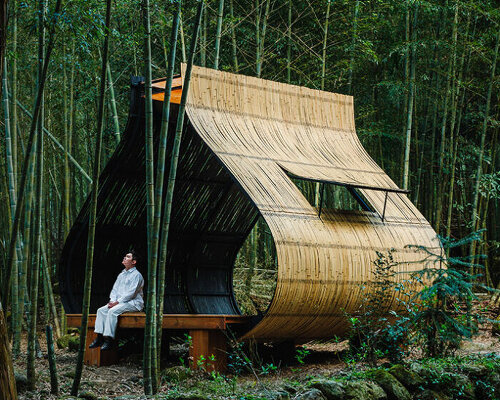Cheng Tsung Feng explores contemporary bamboo expressions
In the shaded depths of a Moso bamboo grove in Nantou, Taiwan, Cheng Tsung Feng has constructed a tranquil resting spot for passersby, shaped like a curiously wrapped dumpling. Titled Bamboo Cabin Plan: Sticky Rice Dumpling, it is built entirely of bamboo and borrows its form from the traditional gesture of making zongzi, the glutinous rice dumpling wrapped in leaves and tied with string.
Here, the familiar shape is translated into a semi-enclosed, semi-open architecture, in which bamboo stalks bend like fingers in a cupped palm, holding the forest’s breeze and serenity as it invites people to step in for a meditative moment of rest. Designed for the Nantou Bamboo Dream Festival, the cabin speaks to its theme of Six Senses by creating a naturally-rooted, immersive spatial installation.
all images courtesy of Cheng Tsung Feng
the cabin draws from the traditional gesture of making zongzi
From a distance, Bamboo Cabin Plan: Sticky Rice Dumpling appears almost as though it has emerged from the forest itself. The open weave of its walls filters light and air, creating a dappled interior animated by the rustle of leaves and the sounds of insects. With an arched silhouette it feels both hand-wrought and organic, evoking traditional wrapping techniques while echoing the slow rhythm of craft. Throughout, Cheng Tsung Feng allows the architecture and its context to become one, with the structure itself embracing the raw tactility of its primary material. In dialogue with the bamboo sprouting from the ground around it, the structure’s palette is designed to age and weather naturally over time.
The intervention reflects the artist’s ongoing exploration of Taiwan’s vernacular crafts and the deeper wisdom embedded in everyday tools. Trained as a designer but working with the sensibility of an anthropologist, Feng is known for reinterpreting traditional techniques, particularly those tied to bamboo weaving and indigenous craftsmanship, with a contemporary eye. Sticky Rice Dumpling joins a growing body of works that occupy a liminal space between art and architecture, sculpture and shelter, such as Feng’s Structural Botany series that examines plant morphology through the lens of modular construction, and the Dragon Palace pavilion reminiscent of marine wildlife anatomy.
set in the shaded depths of a Moso bamboo grove in Nantou, Taiwan
a quiet resting spot for passersby, shaped like a curiously wrapped dumpling
Cheng Tsung Feng explores contemporary bamboo expressions
a semi-enclosed, semi-open architecture
bamboo stalks bend like fingers in a cupped palm, holding the forest’s breeze and serenity
designed for the Nantou Bamboo Dream Festival
the open weave of its walls filters light and air
with an arched silhouette it feels both hand-wrought and organic
throughout, Cheng Tsung Feng allows the bamboo architecture and its context to become one
reflecting the artist’s exploration of Taiwan’s vernacular crafts and the wisdom embedded in everyday tools
evoking traditional wrapping techniques while echoing the slow rhythm of craft
at one with its natural environment
project info:
name: Bamboo Cabin Plan: Sticky Rice Dumpling
artist: Cheng Tsung Feng | @chengtsungfeng
location: Nantou, Taiwan
designboom has received this project from our DIY submissions feature, where we welcome our readers to submit their own work for publication. see more project submissions from our readers here.
edited by: ravail khan | designboom
The post shaped like a sticky rice dumpling, cheng tsung feng’s bamboo cabin nestles in taiwan forest appeared first on designboom | architecture & design magazine.

